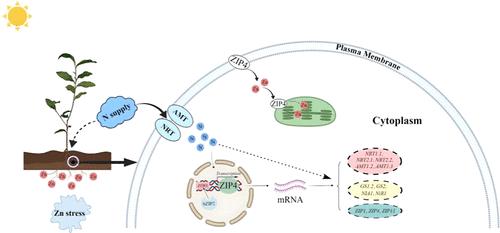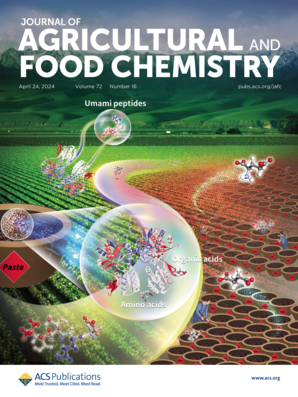Zinc/Iron-Regulated Transporter-like Protein CsZIP4 Enhances Zinc and Nitrogen Uptake and Alleviates Zinc Stresses with Nitrogen Supply in Camellia sinensis
IF 5.7
1区 农林科学
Q1 AGRICULTURE, MULTIDISCIPLINARY
引用次数: 0
Abstract
Zinc (Zn) and nitrogen (N) are the two crucial nutrients for tea plant growth and development and contribute to the quality formation of tea fresh leaves. In this study, a zinc/iron-regulated transporter-like protein 4 gene (i.e., CsZIP4) was functionally characterized. Expression profiling showed that CsZIP4 could be induced by Zn stresses and a N deficiency. Heterologous expression of CsZIP4 in yeast revealed that CsZIP4 possessed the capacity for Zn transport but not ammonium. Moreover, CsZIP4 overexpression in Arabidopsis thaliana promoted Zn and N uptake and transport and contributed to alleviate Zn stresses by collaborating with N supply, which might be interrelated to the expression of N or Zn metabolism-related genes, such as AtNRT1.1 and AtZIP4. Additionally, CsZIP4 was localized in the plasma membrane and chloroplast, which was helpful in maintaining cellular homeostasis under a Zn excess. Furthermore, silencing of CsZIP4 in tea plants by virus-induced gene silencing increased the chlorophyll content but decreased the Zn content. Finally, the yeast one-hybrid assay demonstrated that CsbZIP2 bound to the CsZIP4 promoter. These results will shed light on the functions of CsZIP4 in the N and Zn interaction in tea plants.

锌/铁调节转运体样蛋白 CsZIP4 可促进山茶花对锌和氮的吸收,并通过氮供应缓解锌胁迫
锌(Zn)和氮(N)是茶树生长发育的两种关键营养元素,对茶叶鲜叶品质的形成有重要作用。本研究对锌/铁调控类转运蛋白4基因(即CsZIP4)进行了功能表征。表达谱分析显示,锌胁迫和氮缺乏可诱导 CsZIP4。在酵母中异源表达 CsZIP4 发现,CsZIP4 具有锌转运能力,但不具有铵转运能力。此外,CsZIP4在拟南芥中的过表达促进了锌和氮的吸收和转运,并通过与氮供应的协同作用缓解了锌胁迫,这可能与氮或锌代谢相关基因(如AtNRT1.1和AtZIP4)的表达有关。此外,CsZIP4定位于质膜和叶绿体,有助于在锌过量的情况下维持细胞平衡。此外,通过病毒诱导基因沉默茶树中的 CsZIP4 可增加叶绿素含量,但降低锌含量。最后,酵母单杂交试验证明,CsbZIP2与CsZIP4启动子结合。这些结果将揭示 CsZIP4 在茶树氮和锌相互作用中的功能。
本文章由计算机程序翻译,如有差异,请以英文原文为准。
求助全文
约1分钟内获得全文
求助全文
来源期刊
CiteScore
9.90
自引率
8.20%
发文量
1375
审稿时长
2.3 months
期刊介绍:
The Journal of Agricultural and Food Chemistry publishes high-quality, cutting edge original research representing complete studies and research advances dealing with the chemistry and biochemistry of agriculture and food. The Journal also encourages papers with chemistry and/or biochemistry as a major component combined with biological/sensory/nutritional/toxicological evaluation related to agriculture and/or food.

 求助内容:
求助内容: 应助结果提醒方式:
应助结果提醒方式:


